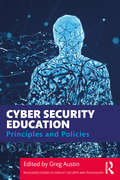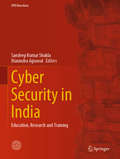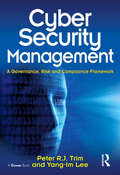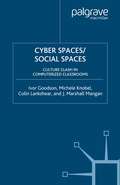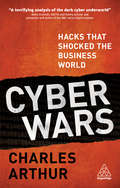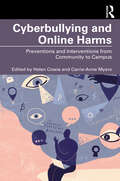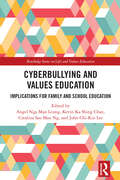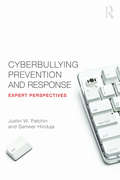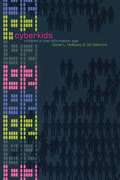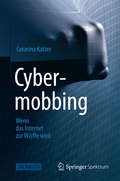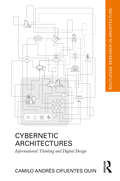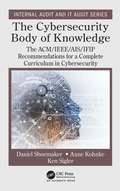- Table View
- List View
Cyber Security Education: Principles and Policies (Routledge Studies in Conflict, Security and Technology)
by Greg AustinThis book investigates the goals and policy aspects of cyber security education in the light of escalating technical, social and geopolitical challenges. The past ten years have seen a tectonic shift in the significance of cyber security education. Once the preserve of small groups of dedicated educators and industry professionals, the subject is now on the frontlines of geopolitical confrontation and business strategy. Global shortages of talent have created pressures on corporate and national policy for workforce development. Cyber Security Education offers an updated approach to the subject as we enter the next decade of technological disruption and political threats. The contributors include scholars and education practitioners from leading research and education centres in Europe, North America and Australia. This book provides essential reference points for education policy on the new social terrain of security in cyberspace and aims to reposition global debates on what education for security in cyberspace can and should mean. This book will be of interest to students of cyber security, cyber education, international security and public policy generally, as well as practitioners and policy-makers.
Cyber Security Education: Principles and Policies (Routledge Studies in Conflict, Security and Technology)
by Greg AustinThis book investigates the goals and policy aspects of cyber security education in the light of escalating technical, social and geopolitical challenges. The past ten years have seen a tectonic shift in the significance of cyber security education. Once the preserve of small groups of dedicated educators and industry professionals, the subject is now on the frontlines of geopolitical confrontation and business strategy. Global shortages of talent have created pressures on corporate and national policy for workforce development. Cyber Security Education offers an updated approach to the subject as we enter the next decade of technological disruption and political threats. The contributors include scholars and education practitioners from leading research and education centres in Europe, North America and Australia. This book provides essential reference points for education policy on the new social terrain of security in cyberspace and aims to reposition global debates on what education for security in cyberspace can and should mean. This book will be of interest to students of cyber security, cyber education, international security and public policy generally, as well as practitioners and policy-makers.
Cyber Security for Educational Leaders: A Guide to Understanding and Implementing Technology Policies
by Richard Phillips Rayton R. SianjinaAs leaders are increasingly implementing technologies into their districts and schools, they need to understand the implications and risks of doing so. Cyber Security for Educational Leaders is a much-needed text on developing, integrating, and understanding technology policies that govern schools and districts. Based on research and best practices, this book discusses the threats associated with technology use and policies and arms aspiring and practicing leaders with the necessary tools to protect their schools and to avoid litigation. Special Features: A Cyber Risk Assessment Checklist and Questionnaire helps leaders measure levels of risk in eight vital areas of technology usage. Case vignettes illuminate issues real leaders have encountered and end-of-chapter questions and activities help readers make connections to their own practice. Chapter alignment with the ELCC standards. An entire chapter on Copyright and Fair Use that prepares leaders for today’s online world. A Companion Website with additional activities, assessment rubrics, learning objectives, and PowerPoint slides.
Cyber Security for Educational Leaders: A Guide to Understanding and Implementing Technology Policies
by Richard Phillips Rayton R. SianjinaAs leaders are increasingly implementing technologies into their districts and schools, they need to understand the implications and risks of doing so. Cyber Security for Educational Leaders is a much-needed text on developing, integrating, and understanding technology policies that govern schools and districts. Based on research and best practices, this book discusses the threats associated with technology use and policies and arms aspiring and practicing leaders with the necessary tools to protect their schools and to avoid litigation. Special Features: A Cyber Risk Assessment Checklist and Questionnaire helps leaders measure levels of risk in eight vital areas of technology usage. Case vignettes illuminate issues real leaders have encountered and end-of-chapter questions and activities help readers make connections to their own practice. Chapter alignment with the ELCC standards. An entire chapter on Copyright and Fair Use that prepares leaders for today’s online world. A Companion Website with additional activities, assessment rubrics, learning objectives, and PowerPoint slides.
Cyber Security in India: Education, Research and Training (IITK Directions #4)
by Sandeep Kumar Shukla Manindra AgrawalThis book of 'directions' focuses on cyber security research, education and training in India, and work in this domain within the Indian Institute of Technology Kanpur. IIT Kanpur's Computer Science and Engineering Department established an ‘Interdisciplinary Center for Cyber Security and Cyber Defense of Critical Infrastructures (C3I Center)’ in 2016 with funding from the Science and Engineering Research Board (SERB), and other funding agencies. The work at the center focuses on smart grid security, manufacturing and other industrial control system security; network, web and data security; cryptography, and penetration techniques. The founders are involved with various Indian government agencies including the Reserve Bank of India, National Critical Information Infrastructure Protection Center, UIDAI, CCTNS under home ministry, Ministry of IT and Electronics, and Department of Science & Technology. The center also testifies to the parliamentary standing committee on cyber security, and has been working with the National Cyber Security Coordinator's office in India. Providing glimpses of the work done at IIT Kanpur, and including perspectives from other Indian institutes where work on cyber security is starting to take shape, the book is a valuable resource for researchers and professionals, as well as educationists and policymakers.
Cyber Security Management: A Governance, Risk and Compliance Framework
by Peter Trim Yang-Im LeeCyber Security Management: A Governance, Risk and Compliance Framework by Peter Trim and Yang-Im Lee has been written for a wide audience. Derived from research, it places security management in a holistic context and outlines how the strategic marketing approach can be used to underpin cyber security in partnership arrangements. The book is unique because it integrates material that is of a highly specialized nature but which can be interpreted by those with a non-specialist background in the area. Indeed, those with a limited knowledge of cyber security will be able to develop a comprehensive understanding of the subject and will be guided into devising and implementing relevant policy, systems and procedures that make the organization better able to withstand the increasingly sophisticated forms of cyber attack. The book includes a sequence-of-events model; an organizational governance framework; a business continuity management planning framework; a multi-cultural communication model; a cyber security management model and strategic management framework; an integrated governance mechanism; an integrated resilience management model; an integrated management model and system; a communication risk management strategy; and recommendations for counteracting a range of cyber threats. Cyber Security Management: A Governance, Risk and Compliance Framework simplifies complex material and provides a multi-disciplinary perspective and an explanation and interpretation of how managers can manage cyber threats in a pro-active manner and work towards counteracting cyber threats both now and in the future.
Cyber Security Management: A Governance, Risk and Compliance Framework
by Peter Trim Yang-Im LeeCyber Security Management: A Governance, Risk and Compliance Framework by Peter Trim and Yang-Im Lee has been written for a wide audience. Derived from research, it places security management in a holistic context and outlines how the strategic marketing approach can be used to underpin cyber security in partnership arrangements. The book is unique because it integrates material that is of a highly specialized nature but which can be interpreted by those with a non-specialist background in the area. Indeed, those with a limited knowledge of cyber security will be able to develop a comprehensive understanding of the subject and will be guided into devising and implementing relevant policy, systems and procedures that make the organization better able to withstand the increasingly sophisticated forms of cyber attack. The book includes a sequence-of-events model; an organizational governance framework; a business continuity management planning framework; a multi-cultural communication model; a cyber security management model and strategic management framework; an integrated governance mechanism; an integrated resilience management model; an integrated management model and system; a communication risk management strategy; and recommendations for counteracting a range of cyber threats. Cyber Security Management: A Governance, Risk and Compliance Framework simplifies complex material and provides a multi-disciplinary perspective and an explanation and interpretation of how managers can manage cyber threats in a pro-active manner and work towards counteracting cyber threats both now and in the future.
Cyber Spaces/Social Spaces: Culture Clash in Computerized Classrooms
by I. Goodson M. Knobel C. Lankshear M. ManganWhat happens when a new social technology is imposed on the established social technology of the school? This book presents an unusual application of critical cultural analysis to a series of empirical case studies of educational uses of information and communication technologies (ICTs). Drawing on research conducted over a ten-year period in three different regions of the Anglo-American developed world, it examines themes arising from the struggle for the social spaces and emerging cyber spaces of schooling; the role of identity projects in educational change; and the paradoxes which arise from these processes. The resulting analysis offers a rich - and sobering - perspective on the rush to technologize classrooms.
Cyber Wars: Hacks that Shocked the Business World
by Charles ArthurCyber Wars gives you the dramatic inside stories of some of the world's biggest cyber attacks. These are the game changing hacks that make organizations around the world tremble and leaders stop and consider just how safe they really are. Charles Arthur provides a gripping account of why each hack happened, what techniques were used, what the consequences were and how they could have been prevented. Cyber attacks are some of the most frightening threats currently facing business leaders and this book provides a deep insight into understanding how they work, how hackers think as well as giving invaluable advice on staying vigilant and avoiding the security mistakes and oversights that can lead to downfall. No organization is safe but by understanding the context within which we now live and what the hacks of the future might look like, you can minimize the threat. In Cyber Wars, you will learn how hackers in a TK Maxx parking lot managed to steal 94m credit card details costing the organization $1bn; how a 17 year old leaked the data of 157,000 TalkTalk customers causing a reputational disaster; how Mirai can infect companies' Internet of Things devices and let hackers control them; how a sophisticated malware attack on Sony caused corporate embarrassment and company-wide shut down; and how a phishing attack on Clinton Campaign Chairman John Podesta's email affected the outcome of the 2016 US election.
Cyber Wars: Hacks that Shocked the Business World
by Charles ArthurCyber Wars gives you the dramatic inside stories of some of the world's biggest cyber attacks. These are the game changing hacks that make organizations around the world tremble and leaders stop and consider just how safe they really are. Charles Arthur provides a gripping account of why each hack happened, what techniques were used, what the consequences were and how they could have been prevented. Cyber attacks are some of the most frightening threats currently facing business leaders and this book provides a deep insight into understanding how they work, how hackers think as well as giving invaluable advice on staying vigilant and avoiding the security mistakes and oversights that can lead to downfall. No organization is safe but by understanding the context within which we now live and what the hacks of the future might look like, you can minimize the threat. In Cyber Wars, you will learn how hackers in a TK Maxx parking lot managed to steal 94m credit card details costing the organization $1bn; how a 17 year old leaked the data of 157,000 TalkTalk customers causing a reputational disaster; how Mirai can infect companies' Internet of Things devices and let hackers control them; how a sophisticated malware attack on Sony caused corporate embarrassment and company-wide shut down; and how a phishing attack on Clinton Campaign Chairman John Podesta's email affected the outcome of the 2016 US election.
Cyberbullying and E-safety: What Educators and Other Professionals Need to Know
by Adrienne Katz"I'd die without my Blackberry" - one young person's comment sums up a generation of young people who are increasingly living their daily lives through their phones and the internet. Cyberbullying is rife, affecting one in five 10-19 year olds. It causes anxiety, unhappiness and mental health problems; in extreme cases even leading to suicide. This book provides a compelling and up to date account of the constantly evolving problem of cyberbullying: the different forms it can take, how the impact differs on boys and girls of different ages, and which children are most vulnerable. Drawing on the findings of the author's survey of over 9,000 children and teenagers, Cyberbullying and E-safety provides a revealing account of the direct experiences and views of children. It describes how a new world where emerging technologies such as smartphones have transformed online social behaviour requires a new, more relevant approach to e-safety and the problem of cyberbullying. The author provides this in the form of a youth-led, age- and gender-appropriate model for cyber-education in the modern world; a 3-tier model comprising universal e-safety education accompanied by targeted and intensive support and advice for children at most risk. She also outlines a school-wide model for preventing and responding to cyberbullying in children, young people and teachers, and provides a wealth of guidance and tools for individuals and schools including templates and lesson plans. Cyberbullying and E-safety is required reading for teachers, counsellors, youth workers, social workers, and other professionals working with children and young people.
Cyberbullying and E-safety: What Educators and Other Professionals Need to Know (PDF)
by Adrienne Katz“I'd die without my Blackberry” – one young person's comment sums up a generation of young people who are increasingly living their daily lives through their phones and the internet. Cyberbullying is rife, affecting one in five 10–19 year olds. It causes anxiety, unhappiness and mental health problems; in extreme cases even leading to suicide. This book provides a compelling and up to date account of the constantly evolving problem of cyberbullying: the different forms it can take, how the impact differs on boys and girls of different ages, and which children are most vulnerable. Drawing on the findings of the author's survey of over 9,000 children and teenagers, Cyberbullying and E-safety provides a revealing account of the direct experiences and views of children. It describes how a new world where emerging technologies such as smartphones have transformed online social behaviour requires a new, more relevant approach to e-safety and the problem of cyberbullying. The author provides this in the form of a youth-led, age- and gender-appropriate model for cyber-education in the modern world; a 3-tier model comprising universal e-safety education accompanied by targeted and intensive support and advice for children at most risk. She also outlines a school-wide model for preventing and responding to cyberbullying in children, young people and teachers, and provides a wealth of guidance and tools for individuals and schools including templates and lesson plans. Cyberbullying and E-safety is required reading for teachers, counsellors, youth workers, social workers, and other professionals working with children and young people.
Cyberbullying and Online Harms: Preventions and Interventions from Community to Campus
by Helen Cowie Carrie-Anne MyersCyberbullying and Online Harms identifies online harms and their impact on young people, from communities to campuses, exploring current and future interventions to reduce and prevent online harassment and aggression. This important resource brings together eminent international researchers whose work shines a light on social issues such as bullying/cyberbullying, racism, homophobia, hate crime, and social exclusion. The text collates into one volume current knowledge and evidence of cyberbullying and its effect on young people, facilitating action to protect victims, challenge perpetrators and develop policies and practices to change cultures that are discriminatory and divisive. It also provides a space where those who have suffered online harms and who have often been silenced in the past may have a voice in telling their experiences and recounting interventions and policies that helped them to create safer spaces in which to live in their community, study in their educational institutions and socialise with their peer group. This is essential reading for researchers, academics, undergraduates and postgraduates in sociology, psychology, criminology, media and communication studies, as well as practitioners and policymakers in psychology, education, sociology, criminology, psychiatry, counselling and psychotherapy, and anyone concerned with the issue of bullying, cyberbullying and online harms among young people in higher education.
Cyberbullying and Online Harms: Preventions and Interventions from Community to Campus
Cyberbullying and Online Harms identifies online harms and their impact on young people, from communities to campuses, exploring current and future interventions to reduce and prevent online harassment and aggression. This important resource brings together eminent international researchers whose work shines a light on social issues such as bullying/cyberbullying, racism, homophobia, hate crime, and social exclusion. The text collates into one volume current knowledge and evidence of cyberbullying and its effect on young people, facilitating action to protect victims, challenge perpetrators and develop policies and practices to change cultures that are discriminatory and divisive. It also provides a space where those who have suffered online harms and who have often been silenced in the past may have a voice in telling their experiences and recounting interventions and policies that helped them to create safer spaces in which to live in their community, study in their educational institutions and socialise with their peer group. This is essential reading for researchers, academics, undergraduates and postgraduates in sociology, psychology, criminology, media and communication studies, as well as practitioners and policymakers in psychology, education, sociology, criminology, psychiatry, counselling and psychotherapy, and anyone concerned with the issue of bullying, cyberbullying and online harms among young people in higher education.
Cyberbullying and Values Education: Implications for Family and School Education (Routledge Series on Life and Values Education)
by Angel Nga Man Leung Kevin Ka Shing Chan Catalina Sau Man Ng John Chi-Kin LeeWritten by scholars from both the Western and Chinese contexts, this monograph discusses the relation between cyberbullying and socio-emotional-moral competencies, feasible interventions by integrating values education, and provides future directions in the field of cyberpsychology. Cyberbullying has become a growing concern in the digital age as it brings devastating impacts on its victims. Educating the younger generation, particularly through values education, also known as character, moral, or social-emotional learning, helps equip children and adolescents with the necessary ethical and moral attitudes, and foster the necessary socio-emotional competencies for them to navigate the digital world as responsible cyber-citizens. A central focus of the book is intervention and education. Cultivating competences and responsible use of technology in the younger generation through values education and evidence-based intervention helps combat cyberbullying. Families, schools, and communities can work together with suitable school programs, teacher education, and parents/school collaboration to help students cope with cyberbullying and create safer online spaces for them. Technology itself is not inherently good or bad but shaped by human choices and values. Supported by empirical evidence and theoretical insights, this book suggests ways to promote moral and emotional skills, foster digital citizenship, and encourage ethical technology design. This book provides a comprehensive understanding of cyberbullying. This timely resource will contribute to creating a safer and more positive online environment for all. It will inform researchers, educators, parents, and the community in combating cyberbullying by enabling children and adolescents to be responsible, ethical, and happy netizens.
Cyberbullying and Values Education: Implications for Family and School Education (Routledge Series on Life and Values Education)
by Angel Nga Man Leung Kevin Ka Shing Chan Catalina Sau Man Ng John Chi-Kin LeeWritten by scholars from both the Western and Chinese contexts, this monograph discusses the relation between cyberbullying and socio-emotional-moral competencies, feasible interventions by integrating values education, and provides future directions in the field of cyberpsychology. Cyberbullying has become a growing concern in the digital age as it brings devastating impacts on its victims. Educating the younger generation, particularly through values education, also known as character, moral, or social-emotional learning, helps equip children and adolescents with the necessary ethical and moral attitudes, and foster the necessary socio-emotional competencies for them to navigate the digital world as responsible cyber-citizens. A central focus of the book is intervention and education. Cultivating competences and responsible use of technology in the younger generation through values education and evidence-based intervention helps combat cyberbullying. Families, schools, and communities can work together with suitable school programs, teacher education, and parents/school collaboration to help students cope with cyberbullying and create safer online spaces for them. Technology itself is not inherently good or bad but shaped by human choices and values. Supported by empirical evidence and theoretical insights, this book suggests ways to promote moral and emotional skills, foster digital citizenship, and encourage ethical technology design. This book provides a comprehensive understanding of cyberbullying. This timely resource will contribute to creating a safer and more positive online environment for all. It will inform researchers, educators, parents, and the community in combating cyberbullying by enabling children and adolescents to be responsible, ethical, and happy netizens.
Cyberbullying Prevention and Response: Expert Perspectives
by Justin W. Patchin Sameer HindujaJust as the previous generation was raised in front of televisions, adolescents at the turn of the 21st century are being raised in an internet-enabled world where blogs, social networking, and instant messaging are competing with face-to-face and telephone communication as the dominant means through which personal interaction takes place. Unfortunately, a small but growing proportion of our youth are being exposed online to interpersonal violence, aggression, and harassment via cyberbullying. The mission of this book is to explore the many critical issues surrounding this new phenomenon. Key features include the following. Comprehensive – The book provides a comprehensive, up-to-date look at the major issues that teachers, school administrators, counsellors, social workers, and parents need to be aware of with respect to cyberbullying identification, prevention, and response. Practical – While the information is informed by research, it is written in an accessible way that all adults will be able to understand and apply. Expertise – Justin W. Patchin and Sameer Hinduja are Co-Directors of the Cyberbullying Research Center (www.cyberbullying.us). Chapter authors represent a carefully selected group of contributors who have demonstrated both topical expertise and an ability to write about the topic in clear, easily accessible language. This book is appropriate for teachers, administrators, parents and others seeking research-based guidance on how to deal with the rising tide of cyberbullying issues. It is also appropriate for a variety of college level courses dealing with school violence and educational administration.
Cyberbullying Prevention and Response: Expert Perspectives
by Justin W. Patchin Sameer HindujaJust as the previous generation was raised in front of televisions, adolescents at the turn of the 21st century are being raised in an internet-enabled world where blogs, social networking, and instant messaging are competing with face-to-face and telephone communication as the dominant means through which personal interaction takes place. Unfortunately, a small but growing proportion of our youth are being exposed online to interpersonal violence, aggression, and harassment via cyberbullying. The mission of this book is to explore the many critical issues surrounding this new phenomenon. Key features include the following. Comprehensive – The book provides a comprehensive, up-to-date look at the major issues that teachers, school administrators, counsellors, social workers, and parents need to be aware of with respect to cyberbullying identification, prevention, and response. Practical – While the information is informed by research, it is written in an accessible way that all adults will be able to understand and apply. Expertise – Justin W. Patchin and Sameer Hinduja are Co-Directors of the Cyberbullying Research Center (www.cyberbullying.us). Chapter authors represent a carefully selected group of contributors who have demonstrated both topical expertise and an ability to write about the topic in clear, easily accessible language. This book is appropriate for teachers, administrators, parents and others seeking research-based guidance on how to deal with the rising tide of cyberbullying issues. It is also appropriate for a variety of college level courses dealing with school violence and educational administration.
Cyberkids: Youth Identities and Communities in an On-line World
by Sarah Holloway Gill ValentineAs Tony Blair has said, "Technology has revolutionised the way we work and is now set to transform education. Children cannot be effective in tomorrow's world if they are trained in yesterday's skills."Cyberkids draws together research in the sociology of childhood and social studies of technology to explore children's experiences in the Information Age. The book addresses key policy debates about social inclusion and exclusion, children's identities and friendships in on-line and off-line worlds and their relationships with families and teachers. It counters contemporary moral panics about children's risk from dangerous strangers on-line, about corruption and lost innocence from adult-centred material on the web and about the addiction to life on the screen. Instead, by showing how children use ICT in balanced and sophisticated ways, the book draws out the importance of everyday uses of technology and the ways in which children's local experiences are embedded within, and in part, constitute the global.
Cyberkids: Youth Identities and Communities in an On-line World
by Sarah Holloway Gill ValentineAs Tony Blair has said, "Technology has revolutionised the way we work and is now set to transform education. Children cannot be effective in tomorrow's world if they are trained in yesterday's skills."Cyberkids draws together research in the sociology of childhood and social studies of technology to explore children's experiences in the Information Age. The book addresses key policy debates about social inclusion and exclusion, children's identities and friendships in on-line and off-line worlds and their relationships with families and teachers. It counters contemporary moral panics about children's risk from dangerous strangers on-line, about corruption and lost innocence from adult-centred material on the web and about the addiction to life on the screen. Instead, by showing how children use ICT in balanced and sophisticated ways, the book draws out the importance of everyday uses of technology and the ways in which children's local experiences are embedded within, and in part, constitute the global.
Cybermobbing - Wenn das Internet zur W@ffe wird
by Catarina KatzerDie Nutzung von Internet-Chatrooms und sozialen Netzwerken wie z.B. Facebook sind mittlerweile die wichtigsten Kommunikationsformen für Kinder und Jugendliche im Cyberspace. Unter der Bedingung vollkommener physischer Anonymität, d.h. ohne zu wissen, wer tatsächlich hinter diesen Chatpartnern steckt, können Teilnehmer aufgrund der synchronen Interaktion ohne Zeitverzögerung mit anderen „chatten“. Dadurch sinkt die Hemmschwelle für bösartige Attacken und Gemeinheiten anderen gegenüber. Es entsteht das ideale Umfeld für Cybermobbing. So werden Eltern, Jugendliche, Lehrer, Pädagogen, Psychologen, Jugendsozialarbeiter oder Streetworker vor neue Herausforderungen gestellt. Sie sind mit dem Internet als neuem Tatort für Phänomene aus dem schulischen Alltag und dem physischen Umfeld konfrontiert. Diese schwierige Aufgabe wird oft durch den Mangel an Erfahrungen in diesem neuen Problembereich erschwert. Das wesentliche Ziel dieses Buches besteht darin, aufzuklären und sinnvolle Antworten auf folgende Fragen zu geben: Wie ist auf Cybermobbing zu reagieren? Wer sind die Täter und wer sind die Opfer? Was können wir präventiv gegen Cybermobbing tun? Es wird Eltern, Lehrer und Jugendliche, sowie alle anderen Interessierten darüber informieren, was in Online-Foren, sozialen Netzwerken, Chatrooms und Videoportalen überhaupt passiert, welche psychischen und psychosomatischen Auswirkungen dies auf die Opfer haben kann und was Freunde, Eltern und Lehrer dagegen tun können. Somit schlägt es eine Brücke zwischen den Jugendlichen Digital Natives und den Erwachsenen Digital Immigrants.
Cybernetic Architectures: Informational Thinking and Digital Design (Routledge Research in Architecture)
by Camilo Andrés Cifuentes QuinFor the past 50 years, the advancements of technology have equipped architects with unique tools that have enabled the development of new computer-mediated design methods, fabrication techniques, and architectural expressions. Simultaneously, in contemporary architecture new frameworks emerged that have radically redefined the traditional conceptions of design, of the built environment, and of the role of architects. Cybernetic Architectures argues that such frameworks have been constructed in direct reference to cybernetic thinking, a thought model that emerged concurrently with the origins of informatics and that embodies the main assumptions, values, and ideals underlying the development of computer science. The book explains how the evolution of the computational perspective in architecture has been parallel to the construction of design issues in reference to the central ideas fostered by the cybernetic model. It unpacks and explains this crucial relationship, in the work of digital architects, between the use of information technology in design and the conception of architectural problems around an informational ontology. This book will appeal to architecture students and scholars interested in understanding the recent transformations in the architectural landscape related to the advent of computer-based design paradigms.
Cybernetic Architectures: Informational Thinking and Digital Design (Routledge Research in Architecture)
by Camilo Andrés Cifuentes QuinFor the past 50 years, the advancements of technology have equipped architects with unique tools that have enabled the development of new computer-mediated design methods, fabrication techniques, and architectural expressions. Simultaneously, in contemporary architecture new frameworks emerged that have radically redefined the traditional conceptions of design, of the built environment, and of the role of architects. Cybernetic Architectures argues that such frameworks have been constructed in direct reference to cybernetic thinking, a thought model that emerged concurrently with the origins of informatics and that embodies the main assumptions, values, and ideals underlying the development of computer science. The book explains how the evolution of the computational perspective in architecture has been parallel to the construction of design issues in reference to the central ideas fostered by the cybernetic model. It unpacks and explains this crucial relationship, in the work of digital architects, between the use of information technology in design and the conception of architectural problems around an informational ontology. This book will appeal to architecture students and scholars interested in understanding the recent transformations in the architectural landscape related to the advent of computer-based design paradigms.
The Cybersecurity Body of Knowledge: The ACM/IEEE/AIS/IFIP Recommendations for a Complete Curriculum in Cybersecurity (Internal Audit and IT Audit)
by Daniel Shoemaker Anne Kohnke Ken SiglerThe Cybersecurity Body of Knowledge explains the content, purpose, and use of eight knowledge areas that define the boundaries of the discipline of cybersecurity. The discussion focuses on, and is driven by, the essential concepts of each knowledge area that collectively capture the cybersecurity body of knowledge to provide a complete picture of the field. This book is based on a brand-new and up to this point unique, global initiative, known as CSEC2017, which was created and endorsed by ACM, IEEE-CS, AIS SIGSEC, and IFIP WG 11.8. This has practical relevance to every educator in the discipline of cybersecurity. Because the specifics of this body of knowledge cannot be imparted in a single text, the authors provide the necessary comprehensive overview. In essence, this is the entry-level survey of the comprehensive field of cybersecurity. It will serve as the roadmap for individuals to later drill down into a specific area of interest. This presentation is also explicitly designed to aid faculty members, administrators, CISOs, policy makers, and stakeholders involved with cybersecurity workforce development initiatives. The book is oriented toward practical application of a computing-based foundation, crosscutting concepts, and essential knowledge and skills of the cybersecurity discipline to meet workforce demands. Dan Shoemaker, PhD, is full professor, senior research scientist, and program director at the University of Detroit Mercy’s Center for Cyber Security and Intelligence Studies. Dan is a former chair of the Cybersecurity & Information Systems Department and has authored numerous books and journal articles focused on cybersecurity. Anne Kohnke, PhD, is an associate professor of cybersecurity and the principle investigator of the Center for Academic Excellence in Cyber Defence at the University of Detroit Mercy. Anne’s research is focused in cybersecurity, risk management, threat modeling, and mitigating attack vectors. Ken Sigler, MS, is a faculty member of the Computer Information Systems (CIS) program at the Auburn Hills campus of Oakland Community College in Michigan. Ken’s research is in the areas of software management, software assurance, and cybersecurity.
The Cybersecurity Body of Knowledge: The ACM/IEEE/AIS/IFIP Recommendations for a Complete Curriculum in Cybersecurity (Internal Audit and IT Audit)
by Daniel Shoemaker Anne Kohnke Ken SiglerThe Cybersecurity Body of Knowledge explains the content, purpose, and use of eight knowledge areas that define the boundaries of the discipline of cybersecurity. The discussion focuses on, and is driven by, the essential concepts of each knowledge area that collectively capture the cybersecurity body of knowledge to provide a complete picture of the field. This book is based on a brand-new and up to this point unique, global initiative, known as CSEC2017, which was created and endorsed by ACM, IEEE-CS, AIS SIGSEC, and IFIP WG 11.8. This has practical relevance to every educator in the discipline of cybersecurity. Because the specifics of this body of knowledge cannot be imparted in a single text, the authors provide the necessary comprehensive overview. In essence, this is the entry-level survey of the comprehensive field of cybersecurity. It will serve as the roadmap for individuals to later drill down into a specific area of interest. This presentation is also explicitly designed to aid faculty members, administrators, CISOs, policy makers, and stakeholders involved with cybersecurity workforce development initiatives. The book is oriented toward practical application of a computing-based foundation, crosscutting concepts, and essential knowledge and skills of the cybersecurity discipline to meet workforce demands. Dan Shoemaker, PhD, is full professor, senior research scientist, and program director at the University of Detroit Mercy’s Center for Cyber Security and Intelligence Studies. Dan is a former chair of the Cybersecurity & Information Systems Department and has authored numerous books and journal articles focused on cybersecurity. Anne Kohnke, PhD, is an associate professor of cybersecurity and the principle investigator of the Center for Academic Excellence in Cyber Defence at the University of Detroit Mercy. Anne’s research is focused in cybersecurity, risk management, threat modeling, and mitigating attack vectors. Ken Sigler, MS, is a faculty member of the Computer Information Systems (CIS) program at the Auburn Hills campus of Oakland Community College in Michigan. Ken’s research is in the areas of software management, software assurance, and cybersecurity.
